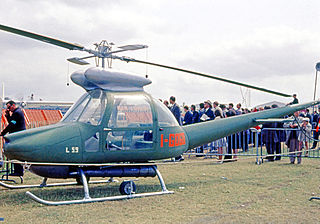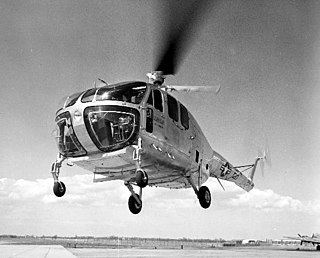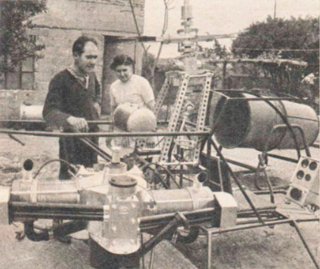Related Research Articles

The Aer Lualdi L.59 was an Italian helicopter that failed to reach quantity production.

The Kamov Ka-26 is a Soviet light utility helicopter with co-axial rotors.

The Agusta A.104 Helicar was an Italian prototype light commercial helicopter first flown in December 1960.

The Partenavia P.64B/P.66B Oscar is an Italian two/four-seat, single-engined, high-wing monoplane built by Partenavia.

The Brantly B-2 is an American two-seat light helicopter produced by the Brantly Helicopter Corporation.

The Bell R-12 was an American 1940s military utility helicopter built by the Bell Helicopter company.

The BŻ-4 Żuk, formerly known as GIL-4, was a Polish four-seat light helicopter built in the 1950s. Although it pioneered a novel rotor and transmission system, it never entered series production.

The Doman LZ-5 was a utility helicopter developed in the United States in the early 1950s by Doman Helicopters Inc. of Danbury, Connecticut. Despite the procurement of international manufacturing agreements, no series production of the aircraft ever occurred and only three prototypes were built. Two of these were purchased by the United States Army as the YH-31, but eventually becoming VH-31.

The Cierva C.8 was an experimental autogyro built by Juan de la Cierva in England in 1926 in association with Avro. Like Cierva's earlier autogyros, the C.8s were based on existing fixed-wing aircraft fuselages – in this case, the Avro 552.

The Cierva CR Twin was a five-seat utility helicopter that first flew in the UK in 1969. It was a joint development between Cierva Autogiro Company and Rotorcraft now a subsidiary of Cierva, based on the dynamic systems of the latter company's Grasshopper design. A new, highly streamlined pod-and-boom fuselage was married to the Grasshopper's coaxial rotor system, and the new aircraft registered G-AWRP first flew on 18 August 1969.

The Firestone XR-9, also known by the company designation Model 45, was a 1940s American experimental helicopter built by the Firestone Aircraft Company for the United States Army Air Forces. Only two were built.

The Gyrodyne RON Rotorcycle was a tiny, single-seat helicopter designed under contract for the United States Navy. in the mid-1950s. It later was redesigned for a U.S. Marine Corps requirement for a small personal helicopter that would fulfill a number of roles, including observation, liaison, small unit tactical maneuvers, and which could be dropped to downed airmen behind enemy lines to facilitate their escape.

The Silvercraft SH-4 is an Italian three-seater light helicopter designed and built by Silvercraft SpA.
The Kamov Ka-126 is a Soviet light utility helicopter with co-axial rotors. Evolved from Ka-26 with engine pods removed from stub wings, fitted with one TVO-100 turboshaft engine positioned on top of fuselage, modified rotor blades, new fuel system.

The Agusta A.105 was an Italian rotorcraft designed by Agusta. It was never developed beyond the prototype stage.

The Ambrosini Rondone is an Italian-designed two/three-seat light touring monoplane of the early 1950s.
The I.P.D BF-1 Beija-Flôr was a two-seat light helicopter designed by Henrich Focke.
The Airmaster H2-B1 is a British two-seat ultralight helicopter built by Airmaster Helicopters of Camberley, Surrey.
The Hillberg EH1-01 RotorMouse is an American helicopter that was designed by Donald Gene Hillberg and produced by Hillberg Helicopters of Fountain Valley, California, first flying in 1993. Now out of production, when it was available the aircraft was supplied as a kit for amateur construction.

The Cicaré CH-1 was a helicopter designed and built by Augusto Cicaré in Argentina in the early 1960s.
References
- ↑ Taylor 1965, p. 95.
- Apostolo, Giorgio. The Illustrated Encyclopedia of Helicopters. New York: Bonanza Books, 1984. Pg.123 ISBN 0-517-439352.
- Taylor, John W. R. (1965). Jane's All The World's Aircraft 1965–66. London: Sampson Low, Marston & Co., Ltd.
- The Illustrated Encyclopedia of Aircraft (Part Work 1982-1985). Orbis Publishing.